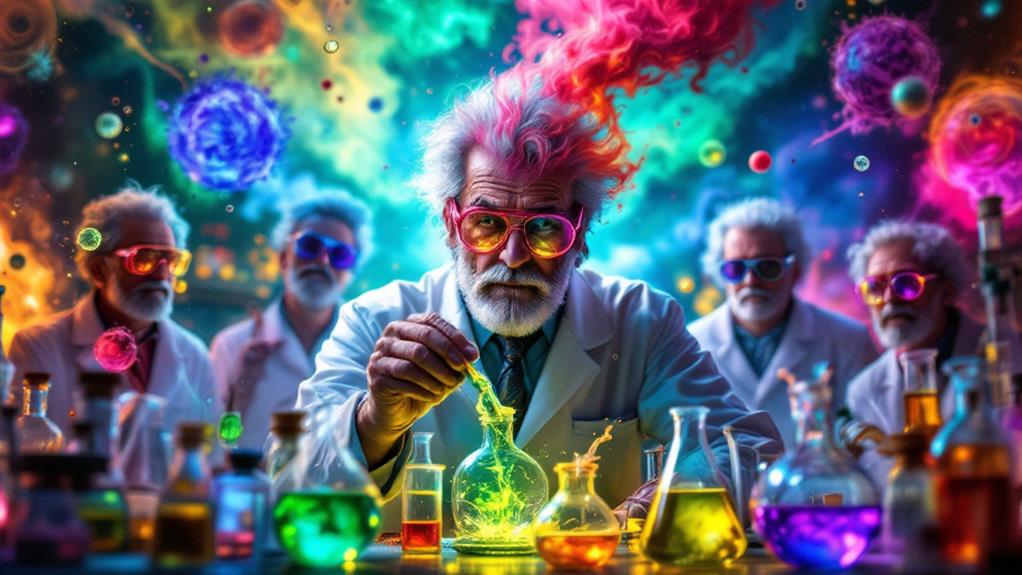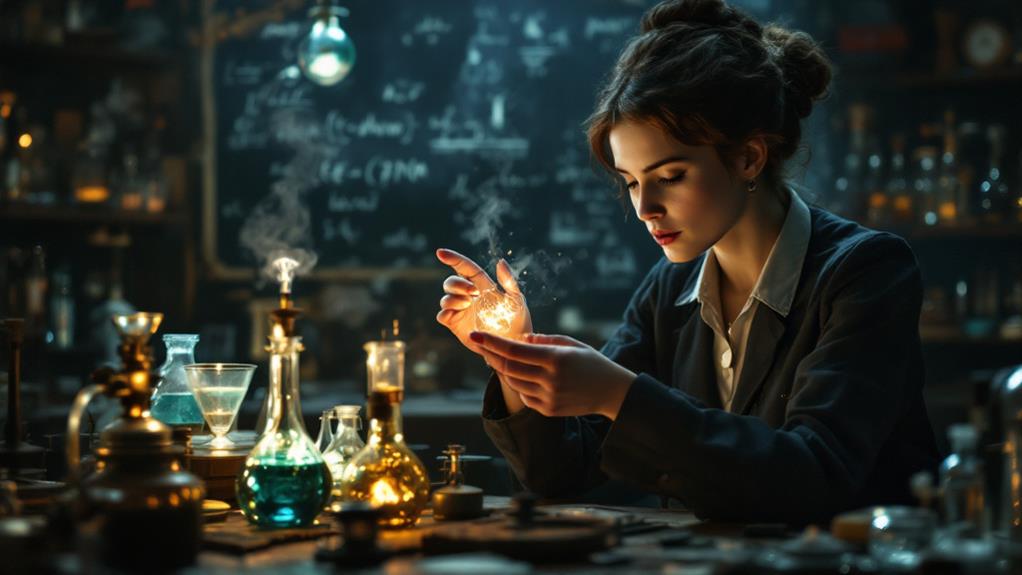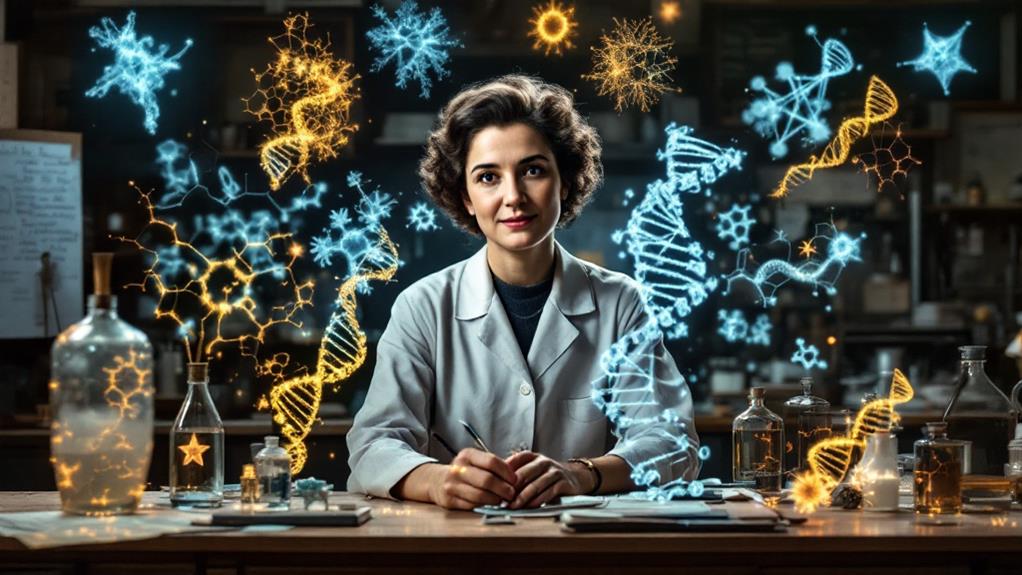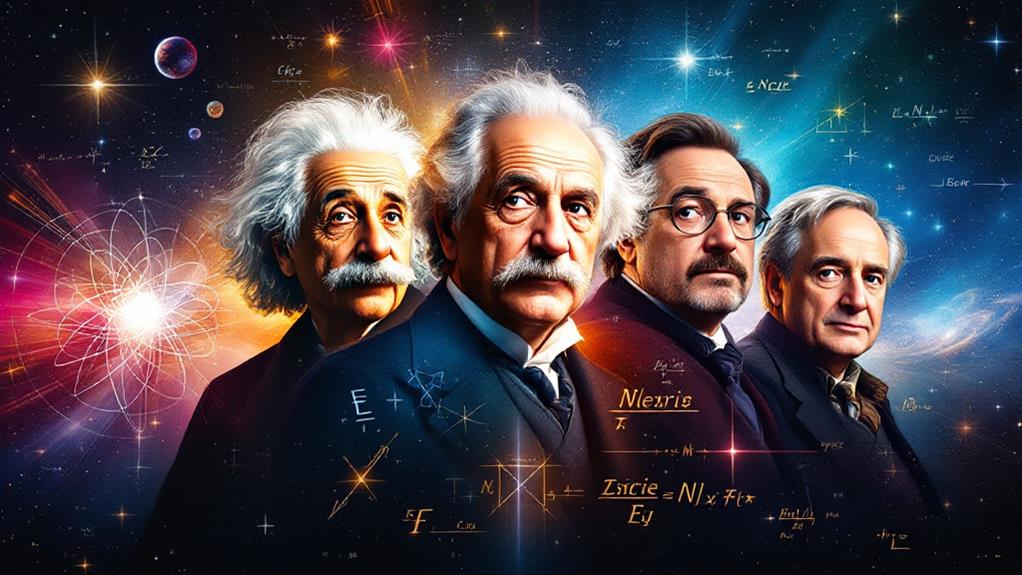Famous Chemists and Their Discoveries: Breakthroughs That Shaped Chemistry

As you investigate the chemical breakthroughs that shaped our world, you're bound to encounter transformative figures like Antoine Lavoisier, who dismantled old theories with his law of conservation of mass. Dmitri Mendeleev reformed element organization with his periodic table, while Marie Curie's pioneering research in radioactivity led to medical advancements. Linus Pauling's insights into molecular structures and Rosalind Franklin's revelations about DNA have altered scientific understanding. Ahmed Zewail's femtochemistry brought new precision to observing reactions. These chemists didn't just change science; they set the stage for future innovations you'll definitely want to know more about.
Antoine Lavoisier: Father of Modern Chemistry
Often hailed as the Father of Modern Chemistry, Antoine Lavoisier transformed the field with his groundbreaking findings. When you immerse yourself in Lavoisier's experiments, you see a thorough approach that redefined how chemistry was understood. He didn't just theorize; he conducted detailed experiments that debunked the phlogiston theory, which posited that a fire-like element was released during combustion. Instead, through careful measurement and observation, Lavoisier demonstrated that combustion involves oxygen, fundamentally altering the scientific perspective on chemical reactions.
His work didn't stop there. Lavoisier's experiments extended to the development of a systematic chemical nomenclature, laying the groundwork for the language of chemistry that you recognize today. He identified and named oxygen and hydrogen, and even helped to construct the law of conservation of mass, which states that matter cannot be created or destroyed in a chemical reaction.
Lavoisier's legacy is monumental. Thanks to his rigorous scientific methods and creative thinking, he established the foundations of modern chemistry. When you study his contributions, you gain insight into a crucial shift from alchemy to a precise science. His legacy continues to influence the way you understand and engage with chemistry.
Dmitri Mendeleev: Periodic Table Pioneer
Dmitri Mendeleev's revolutionary creation of the periodic table transformed the way you understand chemical elements. Before his work, there was no systematic way to classify elements, leading to confusion and inconsistency in chemistry. Mendeleev's genius lay in recognizing patterns among elements and arranging them by increasing atomic weight, while grouping those with similar properties together. This creation wasn't just an organizational tool; it was a groundbreaking method for element classification.
One of Mendeleev's most significant contributions was his ability to make accurate predictions about elements that hadn't been identified yet. By identifying gaps in the table, he predicted the existence and properties of several elements, such as gallium and germanium, before they were actually found. These predictions showcased the power and potential of the periodic table, earning Mendeleev a vital place in the history of science.
You can see the impact of Mendeleev's work in modern chemistry, where the periodic table remains an essential tool for scientists. It helps you understand relationships between elements and predict chemical reactions, making it indispensable in education and research. Mendeleev's legacy continues to shape how you investigate the world of chemistry today.
Marie Curie: Radioactivity Research

Marie Curie's groundbreaking research into radioactivity reshaped your understanding of atomic science. Her pioneering work revealed the mysterious world of radioactive elements, like radium and polonium, which she found alongside her husband, Pierre Curie. Through careful experimentation, Marie Curie isolated radioactive isotopes, fundamentally altering how you perceive atomic particles and their potential.
Curie's legacy is immense. She's not just the initial woman to win a Nobel Prize but the only person to win in two different scientific fields—Physics and Chemistry. Her findings laid the foundation for modern physics and chemistry, influencing countless researchers and leading to significant advancements in numerous fields. As you explore her work, you realize her impact extends beyond the laboratory, inspiring generations of scientists, especially women, to pursue careers in STEM.
When you consider radiation applications, you see Curie's influence in areas like medical imaging and cancer treatment. Her research paved the way for the development of X-rays and radiotherapy, transforming medical diagnostics and patient care. The Curie legacy endures, reminding you of the profound effects one dedicated scientist can have on the world, forever altering the course of science and medicine.
Linus Pauling: Chemical Bonding Insights
Visionary insights into chemical bonding transformed your understanding of molecular structures, thanks to Linus Pauling's contributions. His work on valence theory and hybrid orbitals changed how you perceive atoms and molecules interacting. By introducing the concept of hybrid orbitals, Pauling allowed you to visualize atomic orbital mixing, explaining the geometry of molecules more accurately. With valence theory, he provided a framework for understanding how different atoms combine and form chemical bonds.
Here's what Pauling's work on chemical bonding brought to the table:
- Hybrid Orbitals: He introduced the idea that atomic orbitals could blend into new orbitals, helping explain the shape and strength of bonds.
- Valence Theory: By focusing on electron interactions, he provided a clearer picture of how atoms bond and form molecules.
- Electronegativity: Pauling developed a scale to measure how strongly atoms attract bonding electrons, further refining your understanding of bond formation.
- Resonance Structures: He proposed the concept of resonance, explaining how certain molecules can be represented by multiple structures.
These insights laid the groundwork for advancements in chemistry and related fields. Pauling's contributions continue to impact your understanding of molecular interactions, aiding in developments across scientific disciplines.
Rosalind Franklin: DNA Structure Discovery

In the domain of scientific exploration, Rosalind Franklin's careful work with X-ray diffraction played a significant role in revealing the structure of DNA. When you think about the breakthroughs in molecular biology, Franklin's contributions stand out because of her precise approach. She captured the famous "Photo 51", an X-ray diffraction image that provided critical evidence of DNA's double helix structure. This image was instrumental in piecing together the puzzle of how DNA carries genetic information.
Franklin's expertise in X-ray diffraction allowed her to analyze the DNA fibers with accuracy, helping you understand how the components of DNA fit together. Her work laid the groundwork for others, like Watson and Crick, who built on her findings to develop the double helix model. Although her contributions weren't fully recognized during her lifetime, today you see how vital her research was in advancing molecular biology.
Ahmed Zewail: Femtochemistry Innovator
Through groundbreaking work in the field of femtochemistry, Ahmed Zewail transformed how you understand chemical reactions. By introducing the use of pulsed lasers, he opened new avenues in observing molecular dynamics at unprecedented speeds. Before Zewail's innovation, capturing the fleeting moments of chemical reactions seemed impossible. His work allowed you to witness these processes in real-time, fundamentally changing the study of chemistry.
Zewail's technique involved using ultrafast laser pulses to create a "strobe light" effect, providing snapshots of molecules as they interact and change. This approach gave you a clearer understanding of how molecular bonds break and form, offering insights that were once out of reach.
Here's how Zewail's contributions have impacted the field:
- Visualization: You can now see chemical reactions as they occur, rather than inferring them from static models.
- Precision: Improved precision in measuring reaction times, down to femtoseconds (one quadrillionth of a second).
- Innovation: Encouraged the development of new technologies and methodologies.
- Interdisciplinary Impact: Influenced fields beyond chemistry, including biology and materials science.
Zewail's pioneering work earned him the Nobel Prize in Chemistry in 1999, cementing his legacy as a transformative figure in modern science.


